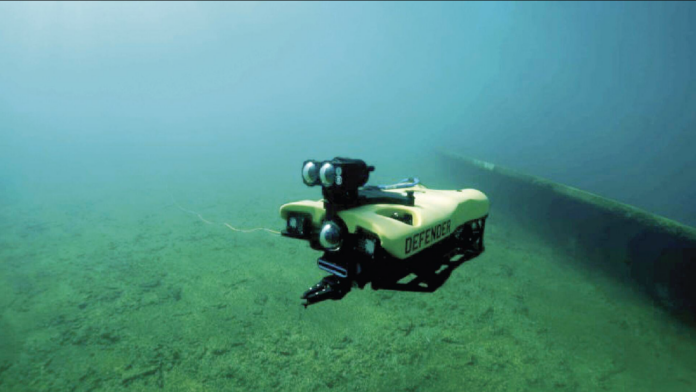Predicted Annual Growth Rate Over the Next DecadeNavigating the Underwater Robotics Frontier: Industry Trends and Growth Prospects 2025-2034Predicted Annual Growth Rate Over the Next Decade
The underwater robotics sector has experienced robust expansion in recent years. In 2024, the market was valued at approximately $4.04 billion, with expectations to grow to $4.53 billion in 2025 – reflecting a compound annual growth rate (CAGR) of 12.3%. This historical growth has been driven by a variety of factors including the demands of deep-sea exploration and extraction, the increasing necessity to monitor and protect marine ecosystems, a rise in search and rescue missions, a booming aquaculture industry, and the development of offshore wind energy farms.
Looking ahead, the underwater robotics market is projected to surge further, reaching an estimated value of $7.14 billion by 2029, corresponding to a CAGR of 12.0%. This expansion is fueled by declining costs of robotics technology, enhanced investments from governmental and research institutions, a boost in commercial applications, the pressing need for regular inspection and maintenance of underwater infrastructures, and growing public interest. During the forecast period, expect significant trends such as advancements in technology, integration of artificial intelligence (AI) and machine learning, the rise of autonomous underwater vehicles, enhanced sensor and communication systems, and developments in collaborative or swarm robotics.
Key Drivers Boosting Market Growth
The increasing number of offshore ventures is a major catalyst for growth in the underwater robotics market. Offshore activities—which can include oil and gas extraction, renewable energy projects, or marine research beyond national waters—are on the rise due to economic efficiencies, growing energy demands, resource availability, and geopolitical stability. Underwater robotics significantly enhance these offshore operations by enabling precise and efficient inspections and maintenance, thereby reducing risks and costs associated with deep-sea operations. For example, data from the UK’s Bureau of Economic Analysis in June 2024 showed an 8.1% increase (or $16.5 billion) in tourism, recreation, and coastal/offshore activities, contributing to a total of $219.7 billion in marine economy output in 2022. This surge in offshore activities is a key driver of market expansion.
Prominent Industry Players
Major companies contributing to the underwater robotics market include:
- Lockheed Martin Corporation
- BAE Systems plc
- General Dynamics Mission Systems Inc.
- Huntington Ingalls Industries
- TechnipFMC plc
Emerging Trends Shaping the Future
Leading firms in the underwater robotics industry are focusing on developing advanced imaging solutions to enhance operational efficiency and the quality of underwater imagery. This involves integrating state-of-the-art imaging technologies to capture, process, and interpret visual data in underwater environments. For instance, in April 2024, VideoRay, an American producer of compact underwater robots, introduced the “Ally” – an entry-level robot designed to support the Maritime Expeditionary Standoff Response (MESR) program. Featuring a 4K Ultra Smart camera with AI capabilities, Ally is engineered to boost productivity and data collection. Its robust, modular design supports heavy loads and various sensors, allowing operators to customize it for specific tasks.
Key Market Segments
The underwater robotics market is categorized into several segments:
- By Type:
- Remotely Operated Vehicles (ROVs)
- Autonomous Underwater Vehicles (AUVs)
- Hybrid ROVs/AUVs
- Unmanned Underwater Vehicles (UUVs)
- Surface-Supported Underwater Robotics
- By Component:
- Light, Camera, Frame, Thrusters, Tethers, Pilot Controls, and Other Components
- By Task Type:
- Observation, Survey, Inspection, Construction, Intervention, Burial and Trenching, and Other Task Types
- By Application:
- Defense and Security, Oil and Gas Exploration, Marine Research and Exploration, Environmental Monitoring, Underwater Construction and Inspection, Search and Rescue, and Scientific Research
Subsegments include:
- For ROVs: Observation, Work-Class, Lightweight, and Tethered ROVs.
- For AUVs: Survey, Exploration, Research, and Military AUVs.
- For Hybrid Systems: Dual-Mode Hybrid Vehicles, Intelligent Hybrid Systems, and Multi-Functional Hybrid Robots.
- For UUVs: Models for Defense, Commercial Use, and Research.
- For Surface-Supported Robotics: Surface-Powered ROVs, Surface Vehicle-Integrated Systems, and Buoyancy-Driven Underwater Robots.
Regional Insights
North America emerged as the largest region in the underwater robotics market in 2024. The comprehensive market report also covers other regions including Asia-Pacific, Western Europe, Eastern Europe, South America, and the Middle East & Africa.
Defining Underwater Robotics
Underwater robotics involves the design and development of robotic systems that operate beneath the water’s surface. These systems are essential for performing tasks such as exploration, monitoring, and research in underwater environments, especially in areas where human access is limited due to depth or hazardous conditions.





